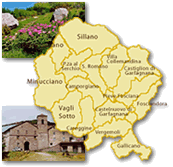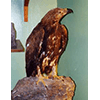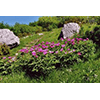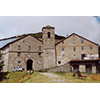Garfagnana

Rich in traditions and historically tied to the middle Serchio Valley by the communication lines that from Tuscany cross the Apennine passes towards Padania, Garfagnana is a natural paradise of great beauty. With its reserves and parks, it offers the tourist in search of its geomorphologic, botanical and faunistic peculiarities, a great variety of destinations.
Between the communes of San Romano, Sillano and Villa Collemandina, about 70 km from Lucca, extends the Parco dell'Orecchiella, the first leg of an itinerary in search of the region’s naturalist treasures. With its more than 5000 hectares of territory and its Visitors Centre, including a Naturalist Museum, guestrooms, a Botanical Garden and a library, the Park offers the visitor a rich and complete picture of the region’s environmental themes.

As early as 1925, the Forests Administration laid the bases for the creation of a homogeneous state property for the reconstitution and defence of forests. In 1927, the Forests District delimited the lands which were to form the Upper Serchio Valley State Forest. The Communes concerned conceded many forests and meadows to the nascent State Forests Corporation which undertook an intense activity of reclamation, reforestation, and soil protection, which was the basis for the successive institution of nature reserves.
"Orecchiella" Park was born in the 1960s. It includes the Regional State Forest and three nature reserves (Orecchiella, Lamarossa and Pania di Corfino) managed by the State Foresters Corp. The Visitors’ Centre hosts reception facilities, the Nature Museum and the Museum of Birds of Prey. The Nature Museum presents dioramas of ungulates in dynamic situations, as well as a series of three-dimensional panels which illustrate the cycle of the traditional natural elements (air, water, earth, fire). The Museum of Birds of Prey presents the life-size reproduction of an eagle’s nest, informational panels on diurnal and nocturnal birds of prey, and display cabinets with stuffed specimens.
(Francesco Marchetti)
Equally interesting and well organised is the Orto Botanico "Pania di Corfino", totally dedicated to the botanical species typical of the Apennines and of the Apuane Alps. Situated almost 1400 metres above sea level, it can be reached from "Orecchiella" Park, travelling Via Bagno up to Corfino, and then taking SP48 up to Villa Collemandina, for a total of about 12 km.

Instituted in 1984 by initiative of the Comunitą Montana della Garfagnana, which is entrusted with its management, the "Pania di Corfino" Botanical Garden is situated 1370 m a.s.l. in the mountain range by the same name. A botanical garden of the Province of Lucca, its purpose is to collect and preserve autochthonous fauna of the Lucca Apennines. Subdivided into specific areas, it reproduces several typical environments of the Apennines and Apuane Alps: peat bog, grasslands, heath, arboretum, hillock and quarry The Hortus Sanitatis section is dedicated to the medicinal and eatable plants of the Garfagnana tradition. The Garden also has a xylological collection (made up of wood samples for study from the botanical and technological viewpoints), housed in the preparation laboratory and made up of longitudinal and transversal sections of the trunks of various tree species on Garfagnana territory. The collection is particularly important from the educational viewpoint, as it offers the possibility to literally touch the sections of the plants found inside and outside of the Botanical Garden.
The Phenological Garden was instituted in 1997. It belongs to the Network of International Phenological Gardens which studies the effects of climate on the development of plants cloned from the same mother plant, depending on the difference of latitude. As they enter, visitors find a sub-fossil silver fir that was found in the area and can be dated to 1200 A.D.
In addition to its intense didactic activity, the Garden promotes study and research, organising conferences dedicated to the knowledge of the plant wealth of Tuscany.
(Anna Toscano)
For those also interested in the area’s ethnographic traditions, a 20 km. detour on SS324/SP72 and SP71 leads to the Museo Don Luigi Pellegrini which, in 14 exhibition halls", presents evidence of country life in the region.

Set up in the ancient medieval hospice of San Pellegrino, it was opened to the public in 1970 under the name of "Museo della Campagna e della Vita di Ieri" ["Museum of the Countryside and Life of Yesterday"], with the aim of illustrating rural society in the Valle del Serchio and the Tuscan-Emilian Apennines. In 1987 the museum took its current name, following the donation of the collection (around 5,000 objects) to the Lucca Provincial Administration which, through the Popular Traditions Centre, has managed it and promoted its scientific activity since then.
The ethnographic collection, displayed in 14 rooms, includes objects collected by Don Luigi Pellegrini, dating mainly from the first years of the 20th century to today. The materials are divided into sections in which replicate the settings of everyday life and work are replicated: the cellar, bedroom, kitchen; agricultural work, spinning and weaving; a shoemaker's shop, a general store, candle-maker, smithy and mill. Noteworthy in particular are two big wooden looms for spinning, various implements for working flax and hemp, and numerous agricultural machines. The Museum also possesses some original furnishings from the Hospital of San Pellegrino, dating from the 17th and 18th centuries.
(Graziano Magrini)
****************************
Texts by Elena Fani
English translation by Victor Beard
Last update 22/gen/2008



 = libraries and archives
= libraries and archives  = scientific research centers
= scientific research centers  = memorial places of scientists
= memorial places of scientists = public health places
= public health places = places of science and worship
= places of science and worship = places of technology
= places of technology  = museums and collections
= museums and collections  = villas and gardens of science
= villas and gardens of science

